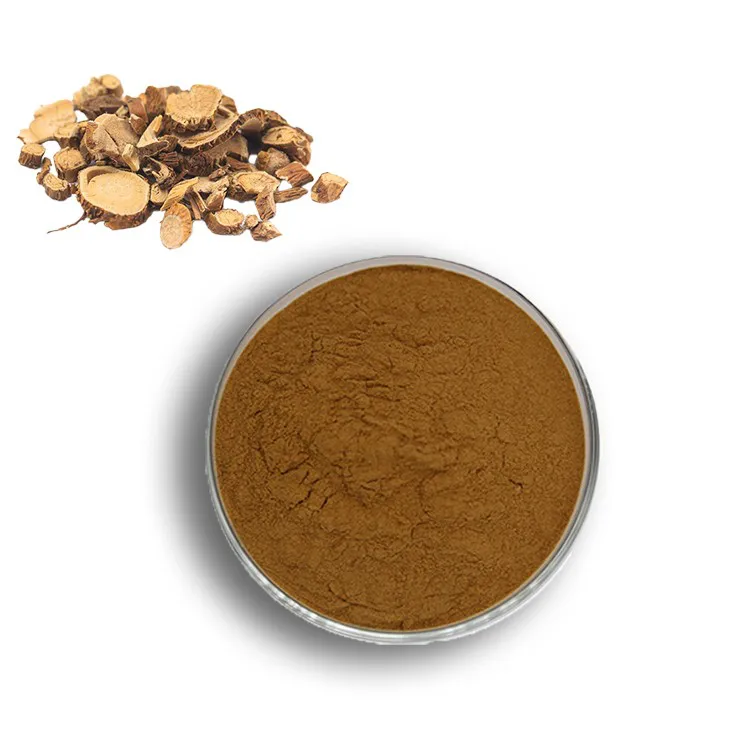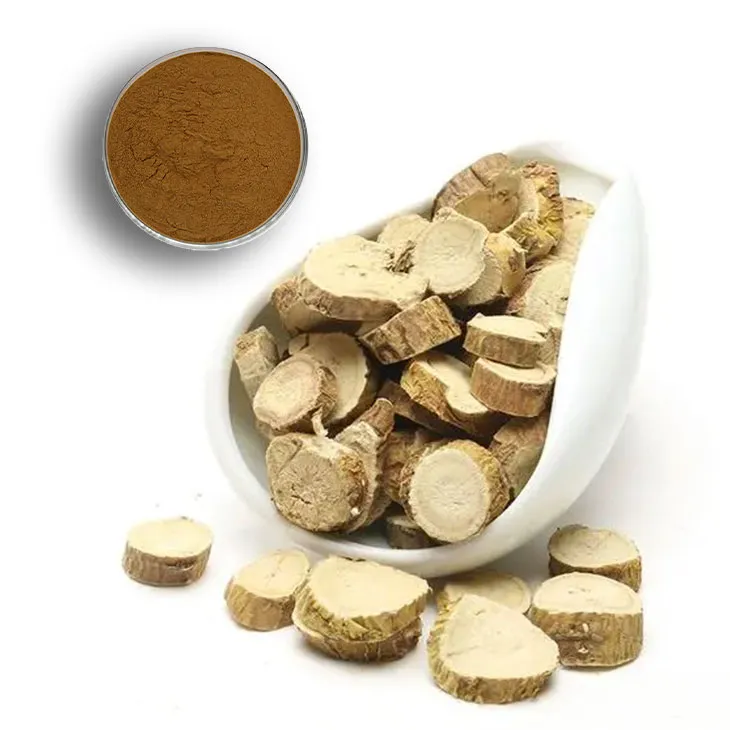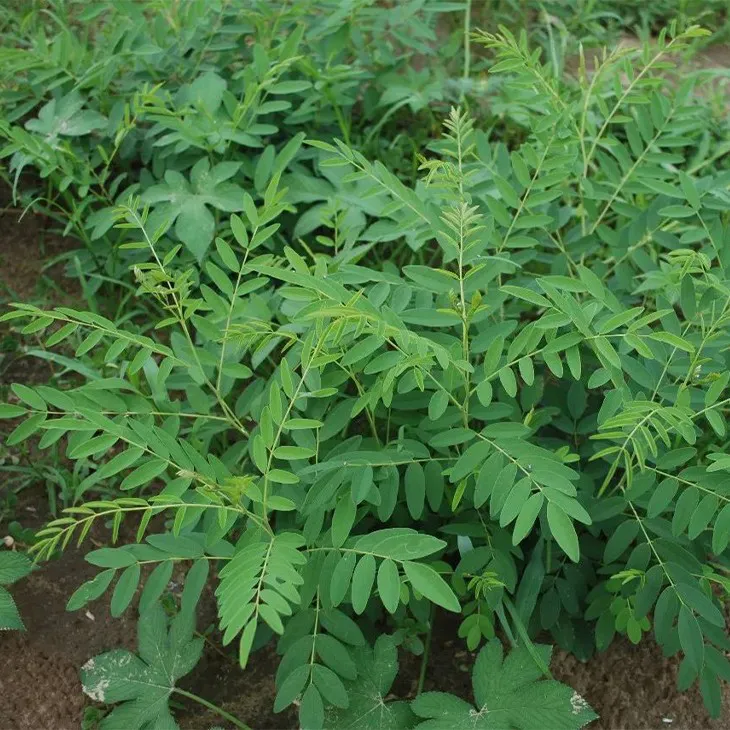- 0086-571-85302990
- sales@greenskybio.com
High - quality Sophora flavescens root extract products.
2024-11-28

1. Introduction to Sophora Flavescens Root Extract
The Sophora Flavescens Root Extract has been attracting significant attention in recent years due to its high - quality properties and diverse applications. This extract is derived from the root of the Sophora flavescens plant, which has a long history of use in traditional medicine systems in many Asian countries.

2. Pharmaceutical Significance
2.1 Bioactive Compounds
The extract is rich in bioactive compounds, among which matrine and oxymatrine are of particular importance. These compounds play crucial roles in the pharmacological activities of the extract.
2.2 Antiviral Properties
Matrine, one of the key components in the Sophora Flavescens Root Extract, has been extensively studied for its antiviral activities. In the context of emerging viral diseases, such as some recent influenza strains or other potential viral threats, the antiviral properties of matrine can be a valuable asset. It can interfere with the viral replication cycle, preventing the virus from multiplying and spreading within the host cells. This mechanism of action makes it a potential candidate for the development of antiviral drugs or as an adjuvant in antiviral therapies.
2.3 Anti - Fibrotic Effects
Oxymatrine, on the other hand, has anti - fibrotic properties. Fibrosis is a pathological process that can occur in various organs, such as the liver and lungs. In liver fibrosis, for example, excessive deposition of extracellular matrix components can lead to the loss of normal liver function over time. Oxymatrine can act on the fibrotic cells and the related signaling pathways, inhibiting the production of fibrotic factors and promoting the degradation of the excessive extracellular matrix. Similarly, in lung fibrosis, it can potentially slow down the progression of the disease by modulating the fibrotic processes. These anti - fibrotic properties make the high - quality Sophora flavescens root extract a valuable resource for pharmaceutical research aiming at treating fibrotic diseases.

3. Agricultural Applications
3.1 Natural Pesticide Potential
The high - quality Sophora flavescens root extract has shown great potential as a natural pesticide. In modern agriculture, the over - reliance on chemical pesticides has led to a series of environmental and health problems. The extract from Sophora flavescens root can be an alternative solution.
It can inhibit the growth of certain pests and fungi. For pests, it may disrupt their physiological functions, such as interfering with their feeding or reproductive behaviors. Regarding fungi, it can prevent the spore germination or the growth of fungal hyphae. This ability to control pests and fungi reduces the need for chemical pesticides, which is not only environmentally friendly but also in line with the concept of sustainable agriculture.

4. Quality Assurance in Production
4.1 Raw Material Selection
For high - quality Sophora flavescens root extract products, the selection of raw materials is the first and crucial step. Only high - quality Sophora flavescens roots are chosen. These roots are carefully sourced from reliable suppliers, and strict quality control measures are applied during the procurement process. Factors such as the origin of the plant, its growth environment, and the harvesting time are all taken into consideration. For example, roots from plants grown in areas with clean soil and water sources, and harvested at the optimal maturity stage, are more likely to produce high - quality extract.
4.2 Optimization of Extraction Processes
The extraction process is optimized to obtain the purest and most effective extract. Different extraction methods, such as solvent extraction, supercritical fluid extraction, etc., are evaluated and compared. The goal is to choose the method that can maximize the extraction of the bioactive compounds while minimizing the extraction of unwanted substances. During the extraction process, parameters like extraction time, temperature, and solvent concentration are carefully controlled to ensure the quality and consistency of the extract.
4.3 Quality Monitoring through Advanced Analytical Techniques
Advanced analytical techniques play a vital role in ensuring the quality of the Sophora flavescens root extract. Techniques such as high - performance liquid chromatography (HPLC), gas chromatography - mass spectrometry (GC - MS), and nuclear magnetic resonance (NMR) are used. HPLC can accurately separate and quantify the bioactive compounds in the extract, such as matrine and oxymatrine. GC - MS can be used to analyze the volatile components in the extract, which may also contribute to its pharmacological or pesticidal activities. NMR can provide detailed structural information about the compounds in the extract. Through these techniques, the quality of the extract can be accurately monitored at every stage of production, ensuring that consumers receive a reliable product with consistent performance.
5. Conclusion
In conclusion, the high - quality Sophora flavescens root extract is a multi - faceted product with great significance. Its applications in the pharmaceutical and agricultural sectors are just the tip of the iceberg. With further research and development, more potential uses may be discovered. The strict quality control measures in its production ensure that it can be a reliable and effective product for various applications. It is a natural product that combines the advantages of traditional knowledge and modern scientific research, and it holds great promise for the future in different fields.
FAQ:
What are the main bioactive compounds in high - quality Sophora flavescens root extract?
Matrine and oxymatrine are two of the main bioactive compounds in high - quality Sophora flavescens root extract. Matrine has strong antiviral activities, while oxymatrine has anti - fibrotic properties.
How does Sophora flavescens root extract contribute to the pharmaceutical industry?
The extract is rich in bioactive compounds. For example, its matrine has antiviral effects which are important for dealing with emerging viral diseases, and oxymatrine has anti - fibrotic properties useful in treating liver and lung fibrosis, making it a valuable resource for pharmaceutical research and drug development.
What role can Sophora flavescens root extract play in agriculture?
It has shown potential as a natural pesticide. It can inhibit the growth of certain pests and fungi, reducing the need for chemical pesticides, thus being environmentally friendly and promoting sustainable agriculture.
How is the quality of high - quality Sophora flavescens root extract ensured?
Strict manufacturing processes are in place. Raw materials are carefully selected, and extraction processes are optimized to obtain the purest and most effective extract. Advanced analytical techniques are used to accurately monitor the quality of the extract, ensuring consumers receive a reliable product with consistent performance.
Why is high - quality Sophora flavescens root extract considered multi - faceted?
It is multi - faceted because it has various applications. In the pharmaceutical realm, it has valuable pharmacological effects. In agriculture, it can be used as a natural pesticide. These different applications in different sectors make it multi - faceted.
Related literature
- Pharmacological Properties of Sophora flavescens Root Extract"
- "Sophora flavescens Root Extract as a Natural Pesticide: A Review"
- "Quality Control in the Production of Sophora flavescens Root Extract"
- ▶ Hesperidin
- ▶ citrus bioflavonoids
- ▶ plant extract
- ▶ lycopene
- ▶ Diosmin
- ▶ Grape seed extract
- ▶ Sea buckthorn Juice Powder
- ▶ Beetroot powder
- ▶ Hops Extract
- ▶ Artichoke Extract
- ▶ Reishi mushroom extract
- ▶ Astaxanthin
- ▶ Green Tea Extract
- ▶ Curcumin Extract
- ▶ Horse Chestnut Extract
- ▶ Other Problems
- ▶ Boswellia Serrata Extract
- ▶ Resveratrol Extract
- ▶ Marigold Extract
- ▶ Grape Leaf Extract
- ▶ blog3
- ▶ blog4
-
Extraction process of black pepper extract.
2024-11-28
-
Wholesale L - Tyrosine Suppliers.
2024-11-28
-
The best milk thistle extract in 2024.
2024-11-28
-
High - quality kidney bean extract products.
2024-11-28
-
The best aged garlic extract on the market.
2024-11-28
-
How to make powder with L - arginine.
2024-11-28
-
Polygonum Cuspidatum Extract
2024-11-28
-
Rose Hip Extract
2024-11-28
-
Stevia Extract
2024-11-28
-
Calendula Extract
2024-11-28
-
Artichoke Extract
2024-11-28
-
Citrus bioflavonoids
2024-11-28
-
Lemon Balm Extract
2024-11-28
-
Plantain extract
2024-11-28
-
Green Tea Extract
2024-11-28
-
Beta Carotene
2024-11-28





















